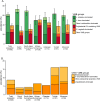The association between ethnicity and vaginal microbiota composition in Amsterdam, the Netherlands
- PMID: 28700747
- PMCID: PMC5507447
- DOI: 10.1371/journal.pone.0181135
The association between ethnicity and vaginal microbiota composition in Amsterdam, the Netherlands
Abstract
Objective: To evaluate whether ethnicity is independently associated with vaginal microbiota (VMB) composition in women living in Amsterdam, the Netherlands, as has been shown for American women.
Methods: Women (18-34 years, non-pregnant, N = 610) representing the six largest ethnic groups (Dutch, African Surinamese, South-Asian Surinamese, Turkish, Moroccan, and Ghanaian) were sampled from the population-based HELIUS study. Sampling was performed irrespective of health status or healthcare seeking behavior. DNA was extracted from self-sampled vaginal swabs and sequenced by Illumina MiSeq (16S rRNA gene V3-V4 region).
Results: The overall prevalence of VMBs not dominated by lactobacilli was 38.5%: 32.2% had a VMB resembling bacterial vaginosis and another 6.2% had a VMB dominated by Bifidobacteriaceae (not including Gardnerella vaginalis), Corynebacterium, or pathobionts (streptococci, staphylococci, Proteus or Enterobacteriaceae). The most prevalent VMB in ethnically Dutch women was a Lactobacillus crispatus-dominated VMB, in African Surinamese and Ghanaian women a polybacterial G. vaginalis-containing VMB, and in the other ethnic groups a L. iners-dominated VMB. After adjustment for sociodemographic, behavioral and clinical factors, African Surinamese ethnicity (adjusted odds ratio (aOR) 5.1, 95% confidence interval (CI) 2.1-12.0) and Ghanaian ethnicity (aOR 4.8, 95% CI 1.8-12.6) were associated with having a polybacterial G. vaginalis-containing VMB, and African Surinamese ethnicity with a L. iners-dominated VMB (aOR 2.8, 95% CI 1.2-6.2). Shorter steady relationship duration, inconsistent condom use with casual partners, and not using hormonal contraception were also associated with having a polybacterial G. vaginalis-containing VMB, but human papillomavirus infection was not. Other sexually transmitted infections were uncommon.
Conclusions: The overall prevalence of having a VMB not dominated by lactobacilli in this population-based cohort of women aged 18-34 years in Amsterdam was high (38.5%), and women of sub-Saharan African descent were significantly more likely to have a polybacterial G. vaginalis-containing VMB than Dutch women independent of modifiable behaviors.
Conflict of interest statement
Figures


Comment in
-
Microbiome: Detecting diversity.Nature. 2017 Oct 4;550(7674):S12-S14. doi: 10.1038/550S12a. Nature. 2017. PMID: 28976947 No abstract available.
References
-
- van de Wijgert JH, Borgdorff H, Verhelst R, Crucitti T, Francis S, Verstraelen H, et al. The vaginal microbiota: what have we learned after a decade of molecular characterization? PLoS One. 2014; 9: e105998 doi: 10.1371/journal.pone.0105998 - DOI - PMC - PubMed
-
- Low N, Chersich MF, Schmidlin K, Egger M, Francis SC, van de Wijgert JH, et al. Intravaginal practices, bacterial vaginosis, and HIV infection in women: individual participant data meta-analysis. PLoS Med. 2011; 8: e1000416 doi: 10.1371/journal.pmed.1000416 - DOI - PMC - PubMed
-
- Goldenberg RL, Culhane JF, Iams JD, Romero R. Epidemiology and causes of preterm birth. Lancet. 2008; 371: 75–84. doi: 10.1016/S0140-6736(08)60074-4 - DOI - PMC - PubMed
-
- Fredricks DN, Fiedler TL, Marrazzo JM. Molecular identification of bacteria associated with bacterial vaginosis. N Engl J Med. 2005; 353: 1899–1911. doi: 10.1056/NEJMoa043802 - DOI - PubMed
MeSH terms
Substances
LinkOut - more resources
Full Text Sources
Other Literature Sources

